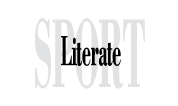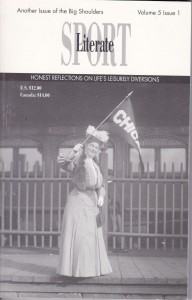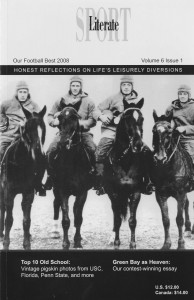Falmouth
https://sportliterate.org/wp-content/themes/osmosis/images/empty/thumbnail.jpg 150 150 bjj-sportliterate bjj-sportliterate https://secure.gravatar.com/avatar/592f60292ffae558017e7047d039bebe88be7eca3a999965f3a7f0501ad82d49?s=96&d=mm&r=gFalmouth
by Dave Fromm
One time my uncle invited me and my cousin Mark to come down to Cape Cod and run in the Falmouth Road Race, a 7-mile “fun run” held every August. My uncle had been running it for years and Mark was a really serious runner. I was not a runner so I said thanks but no thanks and they went ahead with their plans. Then at the last minute Mark had to bail out and my uncle was going to have to run by himself so I said sure I’ll take Mark’s spot even though, being from western Massachusetts, I’m opposed to Cape Cod on principle. Also I hadn’t trained at all, but this was several years ago, right around the end of the part of my life when I thought I could still do things like that.
I made my wife and kids come and we stayed with my aunt and uncle the night before the race. They made a big pasta dinner and we drank lots of Gatorade and beer to hydrate. Very early the next morning my uncle and I got up, drank some coffee and went down to meet a bunch of runners on buses that took us to the start. The buses smelled like Vaseline. I pinned Mark’s registration bib to the front of my t-shirt and ate a granola bar. Then we got into the corrals for the race.
The run began with a long gradual hill which transitioned into a series of rolling woodland hills and then into a very short, steep hill right at the end where terrible people lined the course and yelled at you if you started walking. In between the hills was a long stretch of beachfront where the sun and the salt air combined to suck all the moisture out of your body. The race had something like 14,000 runners and they ran the gamut from Kenyans to people in lobster costumes. I was passed by several people in lobster costumes. Spectators would yell “Come on, Mark! That guy’s wearing a costume!” and I felt bad for this Mark sucker until I remembered that I was wearing a bib with my cousin’s name on it. It was a really long, hot, depressing, and exhausting run. My uncle finished several minutes ahead of me.
At the finish, there was a big expo with food and vendors and music and we got water and more Gatorade and a free hot dog and parts of oranges and bagels. We reconvened with our families in the middle of the field, nursed our strained muscles and congratulated ourselves on surviving. Then we headed towards the cars to drive back to my uncle’s place.
Almost as soon as we left the post-race grounds, I started feeling nauseous, as if my whole body was unraveling from an hour-long clench. The race was so crowded that my wife had had to park almost a half-mile away in a residential neighborhood where every spot of median had a car on it. As I limped behind her, my stomach began to churn. I was glad we were heading back. The immediate future felt ominous and nobody wants to face something ominous in a porta-john at a 14,000-person expo.
“We need to get to my uncle’s,” I said.
“That’s what we’re trying to do,” said my wife.
By the time we reached the car I was cramping up. My wife got behind the wheel and the kids buckled themselves into their car seats. I slid into the passenger side.
“Drive as quick as you can,” I said.
The problem was there was nowhere to go. The neighborhood was a cul-de-sac and cars were bumper-to-bumper all the way around. It took us 20 minutes just to back out of the spot we were in.
I’d stopped sweating around mile 5 but sitting there started to sweat again. The waves of distress were building upon each other. I looked around the neighborhood but it was all residential — no convenience stores, no public libraries, not even a construction site. At that point I would have leapt at the porta-johns at the expo, but they were a half mile away and I no longer had that kind of range.
My wife started to laugh in the desperate way one might if suddenly forced to consider something previously unthinkable happening. The traffic wasn’t moving. We would creep forward, then stop. Creep, then stop. Some stops were short, some stretched into minutes. There was no way to measure progress.
Finally, with the main road still nowhere in sight, everything inside me went silent. But it wasn’t a peaceful quiet. It felt ominous, the quiet of a horror movie right before the jump scare. Except this jump scare would be intestinal. Metaphorically at least, the s- was about to hit the fan. Possibly the radiator.
On our right was a big family picnicking in the front yard of one of those classic clapboard Cape houses.
“I’ve got to ask them,” I said to my wife.
She didn’t say anything. She just stared straight ahead.
I got out of the car and walked quickly up to the family.
They looked at me.
“Hi,” I said, sort of wildly. “Sorry to bother you. It’s just, a long line of cars, you know?”
They didn’t respond, so I cut to the chase.
“And I was wondering if I could, uh, borrow your bathroom real quick?”
Borrow was a funny word to use about a bathroom, partly because it implied that I’d be returning it in the same condition, which wasn’t the case. Perhaps intuiting this, the grandfather in the lawn chair grimaced. It must have been his house. For a second, I thought maybe he was going to say no but he seemed like the kind of person who could recognize an emergency when he saw one. Maybe he was a veteran.
“Lot of Gatorade,” I said, hoping to create a sort of illusion.
The grandfather tilted his head toward the door and one of the younger women said, “I’ll show you where it is.”
She led me inside and pointed up a flight of stairs to an open door.
“Right there,” she said.
I thanked her and got up the stairs as fast as my condition allowed. Their upstairs bathroom was small and nondescript, and I have never felt more grateful to be in a stranger’s home. I locked the door and opened the back window. The episode was dreadful, but as these things go, over in seconds. When I looked for a way to cover my tracks, all I could find was a Cosmopolitan magazine atop the toilet tank. I used it as a fan. It didn’t help.
I washed up, closed the door and raced back down the stairs and across the yard.
“Thank you so much,” I shouted, waving to the family on their picnic blankets. They waved back.
“That was quick,” said my wife.
I wiped the sweat off of my brow.
“Get us out of here,” I said.
She nodded. But there was still nowhere to go.
We sat in the car, right in front of the house, for another 20 minutes, as members of the family went inside and came back out looking aghast. The grandfather’s grimace deepened, and he stared at me like I’d betrayed the platoon. I slunk low in my seat and looked straight ahead until he finally drifted out of sight.
Sometimes I think about that man and his house and his kind family. I wonder whether they gather every year for the Falmouth Road Race and, if they do, whether they tell the story of year a guy jumped out of a car after the race and bombed their lovely upstairs bathroom. I hope they can look back on that event and laugh about it. What a crazy thing! When I look back on it, it’s utterly mortifying, and the only silver lining I can see is that at least they still think that that guy’s name was Mark.
Dave Fromm is the author of a sports memoir entitled Expatriate Games, which chronicles his season playing semi-pro basketball in the Czech Republic in the mid-1990s, and a novel entitled The Duration. He lives in Western Massachusetts with his wife and kids.



 A Meditation on the Almost-Superman, or Maybe Just on
A Meditation on the Almost-Superman, or Maybe Just on 



 After Midnight
After Midnight It’s impressive, this blend of generations and genders. The Friday Night League is made up of 19 males and five females. Scores are tight across the board, and the sportsmanship is uncanny. It’s been my experience that competitive sport leagues are often petri dishes for buried hostilities, but there’s not a whiff of sizing-up to be found.
It’s impressive, this blend of generations and genders. The Friday Night League is made up of 19 males and five females. Scores are tight across the board, and the sportsmanship is uncanny. It’s been my experience that competitive sport leagues are often petri dishes for buried hostilities, but there’s not a whiff of sizing-up to be found. summer, when I saw him in the O.J. documentary, and speaking of his days covering Muhammad Ali for the New York Times. If writers need role models (and why wouldn’t we?), Lipsyte would be one of mine. I shared our Ali-covered “22nd Summer” issue with him and reached out for an interview. His perspective — in a dozen answers to follow — shows he’s a man for all times, past, present, and forthcoming.
summer, when I saw him in the O.J. documentary, and speaking of his days covering Muhammad Ali for the New York Times. If writers need role models (and why wouldn’t we?), Lipsyte would be one of mine. I shared our Ali-covered “22nd Summer” issue with him and reached out for an interview. His perspective — in a dozen answers to follow — shows he’s a man for all times, past, present, and forthcoming. RL: That’s a good question I’ve been trying to answer for myself these past 50 years. I was not an avid sports fan growing up, my parents were totally unaware of sports (maybe they knew about Jackie Robinson). They were New York City public school teachers in Harlem and black Brooklyn, whose dinner table conversations were about inequality and the quest for social justice through education. So I came to the Times at 19, as a copyboy, with a flair for feature-writing and not much sports history or x’s and o’s expertise. I got a lot of freedom at the paper, became a columnist relatively quickly, and so picked my own stories, or at least chose the way I would approach them. Being sent to the 1964 Cassius Clay — Sonny Liston fight was the big break of my career, got me attention and set the course. Through Ali and the book I wrote with Dick Gregory (“Nigger”) I met Malcolm and leaders in the movement and solidified the attitude with which I came into sports. It was no deliberate decision for me to see thoroughbred horse racing and NASCAR as models of class in America, it just seemed plain. Look down at floor during a Final Four and see that something like 80 percent of the players are black and they represent 80 percent white schools. I did try to remind myself that sometimes a cigar is just a cigar (I could get interested in courses for horses and restrictor plates), but I think most writers are directed by a GPS deep in their psyches, unless they are just doing shtick.
RL: That’s a good question I’ve been trying to answer for myself these past 50 years. I was not an avid sports fan growing up, my parents were totally unaware of sports (maybe they knew about Jackie Robinson). They were New York City public school teachers in Harlem and black Brooklyn, whose dinner table conversations were about inequality and the quest for social justice through education. So I came to the Times at 19, as a copyboy, with a flair for feature-writing and not much sports history or x’s and o’s expertise. I got a lot of freedom at the paper, became a columnist relatively quickly, and so picked my own stories, or at least chose the way I would approach them. Being sent to the 1964 Cassius Clay — Sonny Liston fight was the big break of my career, got me attention and set the course. Through Ali and the book I wrote with Dick Gregory (“Nigger”) I met Malcolm and leaders in the movement and solidified the attitude with which I came into sports. It was no deliberate decision for me to see thoroughbred horse racing and NASCAR as models of class in America, it just seemed plain. Look down at floor during a Final Four and see that something like 80 percent of the players are black and they represent 80 percent white schools. I did try to remind myself that sometimes a cigar is just a cigar (I could get interested in courses for horses and restrictor plates), but I think most writers are directed by a GPS deep in their psyches, unless they are just doing shtick.